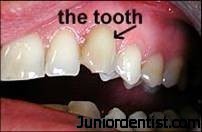Have you ever wondered why your tooth might turn a dull shade of gray or yellow after undergoing a root canal procedure? While root canals are often necessary to save a damaged tooth, they can sometimes leave behind an unsightly discoloration that can affect your confidence in your smile. Fear not! This guide will delve into the causes of tooth discoloration after root canal and provide you with the most effective solutions to restore your pearly whites to their former glory.

Image: tulsaprecisiondental.com
Understanding Tooth Discoloration After Root Canal
A root canal involves removing the infected pulp and nerve tissue from the center of the tooth, followed by cleaning and sealing the root canals. However, this process can compromise the tooth’s natural blood supply, leading to a breakdown of hemoglobin, the protein responsible for giving teeth their color. Over time, this breakdown can cause the tooth to lose its vibrancy and turn discolored.
Additional factors contributing to tooth discoloration after root canal can include:
- Residual infection: If bacteria persist in the root canals, they can continue to release toxins that discolor the tooth.
- Materials used: The filling materials used to seal the root canals can sometimes seep through the tooth structure, causing discoloration.
- Age: As we age, our teeth naturally become darker, which can further accentuate discoloration after root canal.
Effective Solutions to Fix Tooth Discoloration
Fortunately, there are several proven methods to brighten a discolored tooth after root canal:
1. Internal Bleaching:
This technique involves placing a bleaching agent inside the discolored tooth and sealing it with a temporary filling. The bleaching agent is left in place for several days or weeks, gradually lightening the tooth from within.
2. External Bleaching:
If the discoloration is more superficial, external bleaching can be performed using a bleaching gel applied to the outer surface of the tooth. This method typically takes multiple appointments to achieve the desired results.
3. Porcelain Crowns or Veneers:
Crowns or veneers made of porcelain can be used to cover the entire discolored tooth, providing a natural-looking and highly durable solution. This approach is often preferred when the discoloration is severe or affects a large portion of the tooth.
4. Tooth Colored Fillings:
For minor discoloration, tooth-colored fillings can be used to restore the tooth’s appearance by matching the surrounding enamel. This is a relatively inexpensive and minimally invasive option.
Maintaining a Brilliant Smile After Treatment
Once you have successfully restored the brightness of your tooth, it’s crucial to take steps to maintain its radiance:
- Regular brushing and flossing: Good oral hygiene helps prevent new stains from forming and reduces the risk of further discoloration.
- Avoid staining foods and drinks: Limit consumption of coffee, tea, and red wine as these substances can penetrate the tooth structure and cause staining.
- Use a whitening toothpaste: Whitening toothpastes contain mild abrasives that help remove surface stains. However, consult with your dentist before using them frequently to avoid enamel damage.
- Follow-up with your dentist: Regular dental checkups and professional cleanings can help detect and treat any underlying issues that could contribute to discoloration.

Image: www.juniordentist.com
How To Fix Tooth Discoloration After Root Canal
Conclusion
While tooth discoloration after root canal can be a concern, it’s important to know that effective solutions exist to restore the brilliance of your smile. By understanding the causes and choosing the right treatment option, you can confidently regain a radiant and healthy grin. Remember, consulting with your dentist is essential to determine the best approach for your specific situation and to ensure the longevity of your treatment results. Embrace the power of modern dentistry and let your smile shine once again!